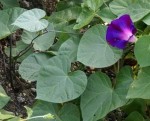 Tall morning glory is an annual vine native to Mexico and Central America. Introduced as an ornamental in the 1700s, it has naturalized in most of the United States except the Rocky Mountains and is considered a noxious weed in some places. It prefers disturbed areas with full sun and rich, moist soil but tolerates less. Gardens, cropland, and waste areas such as roadsides are common habitats.
Tall morning glory is an annual vine native to Mexico and Central America. Introduced as an ornamental in the 1700s, it has naturalized in most of the United States except the Rocky Mountains and is considered a noxious weed in some places. It prefers disturbed areas with full sun and rich, moist soil but tolerates less. Gardens, cropland, and waste areas such as roadsides are common habitats.
 Description: The slender green stems grow up to ten feet long and sprawl in all directions on the ground or climb on other plants or structures. They are covered with brown hairs and bear alternate heart-shaped leaves four inches long on slender petioles that are almost as long as the leaf blades. In mid-summer the plant begins to produces trumpet-shaped flowers singly or in clusters of three or more in shades of white to blue and purple. They are up to three and a half inches across, and open only in the morning. Although each flower last only one day plants continue to produce flowers for two to three months. The flowers are replaced by seed capsules each with four to six dark brown seeds. One plant can produce up to 26,000 seeds. The root system is fibrous and does not re-sprout when cut.
Description: The slender green stems grow up to ten feet long and sprawl in all directions on the ground or climb on other plants or structures. They are covered with brown hairs and bear alternate heart-shaped leaves four inches long on slender petioles that are almost as long as the leaf blades. In mid-summer the plant begins to produces trumpet-shaped flowers singly or in clusters of three or more in shades of white to blue and purple. They are up to three and a half inches across, and open only in the morning. Although each flower last only one day plants continue to produce flowers for two to three months. The flowers are replaced by seed capsules each with four to six dark brown seeds. One plant can produce up to 26,000 seeds. The root system is fibrous and does not re-sprout when cut.

 Control: Mulch will reduce seedling survival and hoeing when plants are young is easy. As the plants mature they can be hand pulled or severed from their roots. Herbicides can be used for large infestations but some resistance to glyphosate has been noted.
Control: Mulch will reduce seedling survival and hoeing when plants are young is easy. As the plants mature they can be hand pulled or severed from their roots. Herbicides can be used for large infestations but some resistance to glyphosate has been noted.